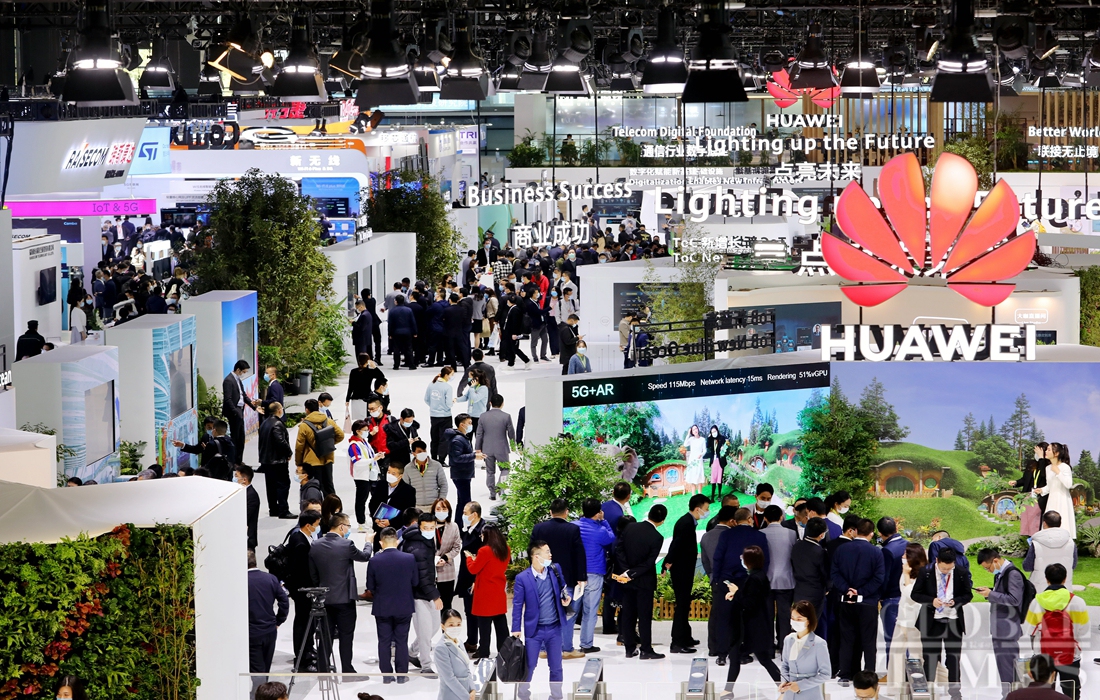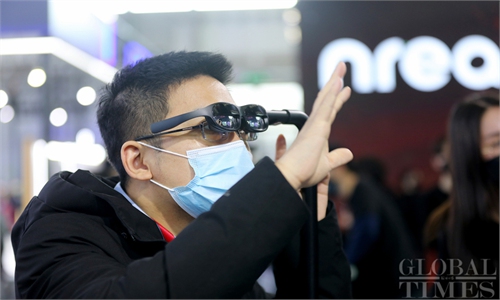China launches MWC2021, rekindles recovery
5G will reach one in five worldwide by 2021, attracts billions of dollars in investment

Photo: Yang Hui/GT
In a rare move, the GSMA, the world's largest telecom industry body that organizes the annual Mobile World Congress, launched this year's event in China in February, as the rest of the world was still struggling with COVID-19.
After the world entered the era of 5G commercialization amid the epidemic in 2020, it is expected to embrace full-scale application on the business side in 2021, with China continuing to take the lead.
About 20,000 visitors and more than 200 exhibitors attend the event, with a major focus on how to empower more business with the next generation of wireless technologies. The GSMA also holds a bullish view on the deployment of 5G in 2021, forecasting that by the end of the year, the technology - with billions of US dollars worth of investment - will reach one in five people. This could help the global economy overcome the effects of the pandemic.
"As we are very proud to note, this is the first physical event after the pandemic," Si Han, head of GSMA Greater China, said in a keynote speech on Tuesday. As the world is still confronting the pandemic, holding the event that was canceled in Barcelona, Spain in February 2020 needs both courage and strength.
It also fully demonstrated the success of China's anti-epidemic work, setting an example for the world and rekindling hopes for an economic recovery driven by the technologies, Jiang Junmu, a Shanghai-based veteran industry expert who also attended the event, told the Global Times.
"The country has also applied many new digital technologies to anti-epidemic work, offering new experience to the world," he said.
Though the Chinese mainland recorded zero new domestically transmitted coronavirus cases for a week, Shanghai kicked off the MWC 2021 in a highly cautious manner by requiring a seven-day valid negative nucleic acid test from attendees outside Shanghai and a green health code. All arrivals from the high- and mid-risk areas for epidemic control were barred from attending the event.
Global Times reporters saw few attendees from foreign countries. Most speakers from foreign carriers like Rima Qureshi, chief strategy officer of US carrier Verizon and Mats Granryd, director general of the GSMA, delivered their remarks by video.
Some of attendees who spoke with the Global Times showed no worries about the event triggering a new outbreak, given China's anti-epidemic measures, which have been effective, and the rapid use vaccines. Gao Fu, director of the Chinese Center for Disease Control and Prevention (CDC) recently said the country has entered the final stage of eliminating the epidemic.
With the rapid deployment and popularization of technology, China has become one of the global leaders in 5G applications and the world's largest 5G market, according to a report unveiled on Monday by GSMA.
China has launched 718,000 5G base stations, accounting for 70 percent of the global total, Liu Liehong, vice minister of Industry and Information Technology, said in the keynote speech on Tuesday.
The country has more than 200 million 5G subscribers, with 218 types of 5G smartphones on the market, Liu noted. Application scenarios of 5G are empowering industries including mining, healthcare, ports and manufacturing, and cumulative investment in 5G networks has surpassed 260 billion yuan ($40.2 billion).
Despite the COVID-19 epidemic in 2020, there were more than 200 million new connections in China, the GSMA said in a document sent to the Global Times. By 2025, nearly half of the connections in China's mobile industry will be made with 5G technologies. From 2020 to 2025, a total of 1.36 trillion yuan is expected to be invested in mobile construction, of which 90 percent will be used in 5G.
If we called 2020 the starting year for 5G commercialization, then 2021 will be the moment when we see large-scale industrial applications, Jiang said. It's crucial for industries to cooperate, instead of being divided.
In recent years, by viewing China as a systemic and strategic rival on the high-technology front, the US has used its sovereignty to challenge China in the 5G race. But the industry itself seems to have gone in a different direction, in contrast to the Washington-led global containment of Chinese companies like Huawei, calling for a larger, deeper and more comprehensive collaboration on application and technological standards.
Under the US' extreme crackdown and multiple rounds of sanctions, Huawei survived and grew in 2020. In spite of the pandemic, it signed more telecom contracts overseas while supplying more than 300 networks in more than 170 countries and regions, a senior executive said on Tuesday.
"Our performance in 2020 was relatively robust, which basically met our expectations," Ken Hu, Huawei's rotating chairman, said in a keynote speech at the MWC2021 in Shanghai.
Revenues and profits both grew slightly last year, which could not have happened without the cooperation of the industry and its partners, Hu noted. Huawei has signed more than 1,000 contacts concerning 5G empowering businesses, covering over 20 industries.
The COVID-19 pandemic worldwide also boosted new demand for digital infrastructure, and Huawei continued to deliver telecom equipment and products in spite of the Washington-led global crackdown on its 5G technologies.
Hu told the audience that in Indonesia, for example, the company deployed over 50,000 base stations amid the pandemic.
In spite of the COVID-19 pandemic, the world commercialization of 5G moved forward robustly. As of the end of 2020, a total of 52 countries and regions worldwide with 135 carriers had deployed 5G services, the GSMA said.
It predicted that by the end of 2021, a total of 178 carriers will have deployed 5G services in 61 countries and regions.


